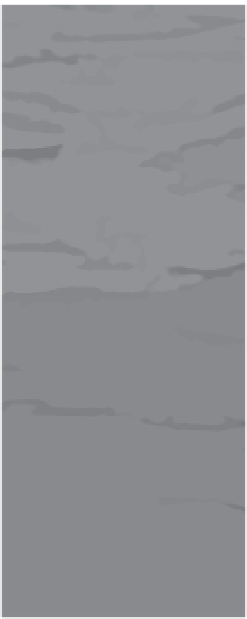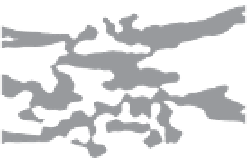Geoscience Reference
In-Depth Information
Potential map
Filtered potential map
300
300
400
400
500
500
600
600
700
700
Figure 6.21
Edge detection from the potential
map using an image sharpening filter in domain
ℜ
. This is done with the image processing
toolbox of MATLAB (function imsharpen). The
structural information contained in the filtered
potential map is used to impose textural
information onto the electrical resistivity
tomogram.
800
800
900
900
100
150
200
250
300
100
150
200
250
300
Distance (m)
Distance (m)
(a)
(b)
value for the L2 scheme is on the range of 0.01
0.1 using
the L-curve approach. For our image-guided scheme,
we enforce a constant value for all iterations. Larger
values of the Lagrange parameter,
-
magnitude of the electrical field produced by the seismo-
electric coupling for three fundamental reasons:
1
We did not care about the amplitude of the electrical
potentials when we built a seismoelectric image.
Indeed, the only things that matter in building the
seismoelectric image displayed in Figure 6.20 are
the local variations of the electrical potentials that
map heterogeneities. Geometrical spreading could
be accounted for, but this was not done in building
Figure 6.20.
2
The conversions need only to be higher than the
background noise. Typically, the electrical noise is on
the order of 1
, enforce structural
similarity within each layer (conductivity values show
less variation within each formation) and have a negative
effect on the data RMS. We see clearly from Figure 6.25
that the texture of the resistivity tomogram is improved
and that the resistivity values are closer to the true resis-
tivity value by comparison with the tomogram obtained
in Figure 6.23. Such an improvement is very important
in order to be able to reliably apply petrophysical models
to be able to transform resistivity or complex conductivity
into relevant parameters such a saturation, salinity,
porosity, or permeability.
β
Vm
−
1
for the electrical field but can
decrease down to 1 nVm
−
1
at depth.
3
If electrical noise is high, stacking may be required.
One way to stack seismoelectric signals would be to
repeat the same seismic (Ricker wavelet) sources.
Another possibility would be to inject a harmonic pres-
sure source and to stack the resulting harmonic
electrical field over the number of cycles needed
to have a good signal-to-noise ratio. Therefore,
μ
6.3.3 Discussion
We have shown that by focusing seismic waves at set
of points, we can image the structural heterogeneities of
formations. However, we have not discussed the order of
in













































































































































































































































































































































































































































































































































































































































































































































































































































































































































































































































































































































































































































































































































































































































































































































































































































































































































































































































































































































































































































































































































































































































































































































































































































































































































































































































































































































































































































































































































































































































































































































































































































































































































































































































































































































































































































































































































































































































































































































































































































































































































































































































































































































































































































































































































































































































































































































































































































































































































































































































































































































































































































































































































































































































































































































































































































































































































































































































































































































































































































































































































































































































































































































































































































































































































































































































































































































































































































































































































































































































































































































































































































































































































































































































































































































































































































































































































































































































































































































































































































































































































































































































































































































































































































































































































































































































































































































































































































































































































































































































































































































































































































































































































































































































































































































































































































































































































































































































































































































































































































































































































































































































































































































































































































































































































































































































































































































































































































































































































































































































































































































































































































































































































































































































































































































































































































































































































































































































































































































































































































































































































































































































































































































































































































































































































































































































































































































































































































































































































































































































































































































































































































































































































































































































































































































































































































































































































































































































































































































































































































































































































































































































































































































































































































































































































































































































































































































































































































































































































































































































































































































































































































































































































































































































































































































































































































































































































































































































































































































































































































































































































































































































































































































































































































































































































































































































































































































































































































































































































































































































































































































































































































































































































































































































































































































































































































































































































































































































































































































































































































































































































































































































































































































































































































































































































































































































































































































































































































































































































































































































































































































































































































































































































































































































































































































































































































































































































































































































































































































































































































































































































































































































































































































































































































































































































































































































































































































































































































































































































































































































































































































































































































































































































































































































































































































































































































































































































































































































































































































































































































































































































































































































































































































































































































































































































































































































































































































































































































































































































































































































































































































































































































































































































































































































































































































































































































































































































































































































































































































































































































































































































































































































































































































































































































































































































































































































































































































































































































































































































































































































































































































































































































































































































































































































































































































































































































































































































































































































































































































































































































































































































































































































































































































































































































































































































































































































































































































































































































































































































































































































































































































































































































































































































































































































































































































































































































































































































































































































































































































































































































































































































































































































































































































































































































































































































































































































































































































































































































































































































































































































































































































































































































































































































































































































































































































































































































































































































































































































































































































































































































































































































































































































































































































































































































































































































































































































































































































































































































































































































































































































































































































































































































































































































































































































































































































































































































































































































































































































































































































































































































































































































































































































































































































































































































































































































































































































































































































































































































































































































































































































































































































































































































































































































































































































































































































































































































































































































































































































































































































































































































































































































































































































































































































































































































































































































































































































































































































































































































































































































































































































































































































































































































































































































































































































































































































































































































































































































































































































































































































































































































































































































































































































































































































































































































































































































































































































































































































































































































































































































































































































































































































































































































































































































































































































































































































































































































































































































































































































































































































































































































































































































































































































































































































































































































































































































































































































































































































































































































































































































































































































































































































































































































































































































































































































































































































































































































































































































































































































































































































































































































































































































































































































































































































































































































































































































































































































































































































































































































































































































































































































































































































































































































































































































































































































































































































































































































































































































































































































































































































































































































































































































































































































































































































































































































































































































































































































































































































































































































































































































































































































































































































































































































































































































































































































































































































































































































































































































































































































































































































































































































































































































































































































































































































































































































































































































































































































































































































































































































































































































































































































































































































































































































































































































































































































































































































































































































































































































































































































































































































































































































































































































































































































































































































































































































































































































































































































































































































































































































































































































































































































































































































































































































































































































































































































































































































































































































































































































































































































































































































































































































































































































































































































































































































































































































































































































































































































































































































































































































































































































































































































































































































































































































































































































































































































































































































































































































































































































































































































































































































































































































































































































































































































































































































































































































































































































































































































































































































































































































































































































































































































































































































































































































































































































































































































































































































































































































































































































































































































































































































































































































































































































































































































































































































































































































































































































































































































































































































































































































































































































































































































































































































































































































































































































































































































































































































































































































































































































































































































































































































































































































































































































































































































































































































































































































































































































































































































































































































































































































































































































































































































































































































































































































































































































































































































































































































































































































































































































































































































































































































































































































































































































































































































































































































































































































































































































































































































































































































































































































































































































































































































































































































































































































































































































































































































































































































































































































































































































































































































































































































































































































































































































































































































































































































































































































































































































































































































































































































































































































































































































































































































































































































































































































































































































































































































































































































































































































































































































































































































































































































































































































































































































































































































































































































































































































































































































































































































































































































































































































































































































































































































































































































































































































































































































































































































































































































































































































































































































































































































































































































































































































































































































































































































































































































































































































































































































































































































































































































































































































































































































































































































































































































































































































































































































































































































































































































































































































































































































































































































































































































































































































































































































































